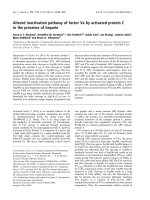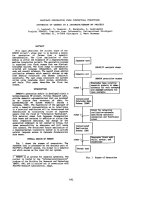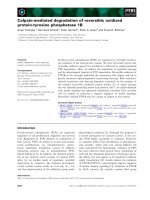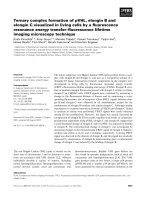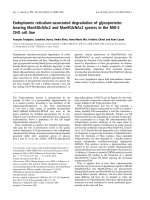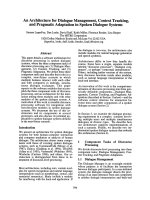Báo cáo khóa học: Endoplasmic reticulum-associated degradation of glycoproteins bearing Man5GlcNAc2 and Man9GlcNAc2 species in the MI8-5 CHO cell line docx
Bạn đang xem bản rút gọn của tài liệu. Xem và tải ngay bản đầy đủ của tài liệu tại đây (332.27 KB, 7 trang )
Endoplasmic reticulum-associated degradation of glycoproteins
bearing Man5GlcNAc2 and Man9GlcNAc2 species in the MI8-5
CHO cell line
Franc¸ois Foulquier, Sandrine Duvet, Andre
´
Klein, Anne-Marie Mir, Fre
´
de
´
ric Chirat and Rene
´
Cacan
Unite
´
de Glycobiologie Structurale et Fonctionnelle, CNRS-UMR 8576, IFR 118, GDR CNRS 2590, Universite
´
des Sciences
et Technologies de Lille, Villeneuve d’Ascq, France
Endoplasmic reticulum-associated degradation of newly
synthesized glycoproteins has been demonstrated previously
using various mammalian cell lines. Depending on the cell
type, glycoproteins bearing Man9 glycans and glycoproteins
bearing Man5 glycans can be efficiently degraded. A wide
variety of variables can lead to defective synthesis of lipid-
linked oligosaccharides and, therefore, in mammalian cells,
species derived from Man9GlcNAc2 or Man5GlcNAc2 are
often recovered on newly synthesized glycoproteins. The
degradation of glycoproteins bearing these two species has
not been studied. We used a Chinese hamster ovary cell
line lacking Glc-P-Dol-dependent glucosyltransferase I to
generate various proportions of Man5GlcNAc2 and
Man9GlcNAc2 on newly synthesized glycoproteins. By
studying the structure of the soluble oligomannosides pro-
duced by degradation of these glycoproteins, we demon-
strated the presence of a higher proportion of soluble
oligomannosides originating from truncated glycans,
showing that glycoproteins bearing Man5GlcNAc2 glycans
are degraded preferentially.
Keywords: degradation signal; lipid intermediates; manno-
sidase activity; N-glycosylation; soluble oligomannosides.
The N-glycosylation process is characterized by the
transfer Ôen blocÕ of a preassembled oligosaccharide on
to a nascent protein. According to the specificity of the
oligosaccharyltransferase, it has been demonstrated
in vitro that a wide variety of assembly intermediates
Glc(0–3)Man(0–9)GlcNAc2-PP-Dol can serve as the
donor substrate for N-linked glycosylation [1]. In vivo,
Gilmore and coworkers have determined that oligosacch-
aryltransferase shows a preference for the full length
oligosaccharide substrate [2].
Once transferred to proteins, the N-linked oligosaccha-
rides play the role of information carrier in the quality
control mechanism of N-glycoproteins in the endoplasmic
reticulum (ER). Indeed, monoglucosylated oligosaccharides
generated either after sequential action of glucosi-
dase I and II or by the soluble UDP-Glc–glycoprotein
glucosyltransferase (UGGT) can be ligands for the mole-
cular lectin-like chaperones calnexin and calreticulin until
proper folding of the N-glycoproteins [3,4].
With N-glycoproteins that fail to fold correctly, a
Man8GlcNAc2 species is generated by an ER a1,2-manno-
sidase, probably ER mannosidase I, and this constitutes a
putative degradation signal [5]. Recently, Frenkel et al. [6]
demonstrated that the degradation of unstable N-glycopro-
teins accumulated in a rough ER subcompartment (QC
compartment) involves trimming of the sugar chain to
Man(6–5)GlcNAc2 species. Furthermore, by using a mutant
cell line that synthesizes truncated Man5GlcNAc2, Ermon-
val et al. [7] showed that the degradation of a soluble form
of ribophorin I required the formation of Man4GlcNAc2.
After the trimming of Man residues, these misfolded
N-glycoproteins are then degraded by a specific pathway
named endoplasmic reticulum-associated degradation
(ERAD). This pathway involves a deglycosylation step
located in the cytosol, and the soluble oligomannosides
released by this process were then submitted to the action of a
1,4-dideoxy-1,4-imino-
D
-mannitol (DIM)-sensitive cytosolic
mannosidase [8], leading to the formation of a specific
Man5GlcNAc1 isomer [9] before entering the lysosomal
compartment [10].
Thus, it appears that at least three oligomannoside
structures may be involved as degradation signal for ERAD
(Man8GlcNAc2 and Man6GlcNAc2 for glycoproteins
bearing Man9 species and Man4GlcNAc2 for glycoproteins
bearing Man5 species). However, this has been observed
using different cell lines. So we decided to study the
degradation of N-glycoproteins when these oligomannoside
structures are both transferred to newly synthesized glyco-
proteins in the same cell line.
Correspondence to R. Cacan, Unite
´
de Glycobiologie Structurale et
Fonctionnelle, CNRS-UMR 8576, Universite
´
desSciencesetTech-
nologies de Lille, F-59655 Villeneuve d’Ascq Cedex, France.
Fax: + 33 3 20 43 65 55, Tel.: + 33 3 20 43 44 30,
E-mail:
Abbreviations: CHO, Chinese hamster ovary; DIM, 1,4-dideoxy-1,4-
imino-
D
-mannitol; Dol, dolichol; ERAD, endoplasmic reticulum-
associated degradation; ER, endoplasmic reticulum; LLO, lipid-linked
oligosaccharide; PNGase, peptide N-glycanase F; UGGT,
UDP-glucose–glycoprotein glucosyltransferase; UPR,
unfolded protein response.
Enzymes:peptideN-glycanase F (PNGase; EC 3.2.2.18); b-galactosi-
dase (EC 3.2.1.23); b-hexosaminidase (EC 3.2.1.30).
(Received 15 September 2003, revised 21 October 2003,
accepted 21 November 2003)
Eur. J. Biochem. 271, 398–404 (2004) Ó FEBS 2003 doi:10.1046/j.1432-1033.2003.03938.x
Using the MI8-5 cell line which is unable to synthesize
glucosylated lipid-linked oligosaccharides (LLOs), but in
which UGGT remains active, we show that non-glucosyl-
ated Man5GlcNAc2-PP-Dol could be efficiently transferred
to glycoproteins. In contrast with that observed in vitro,
Man5GlcNAc2 bound to glycoproteins was efficiently
glucosylated. By studying the degradation process, as
revealed by the structure of the released soluble oligoman-
nosides, we demonstrate that glycoproteins bearing Man5
are preferentially degraded over glycoproteins bearing
Man9.
Experimental procedures
Materials
[2-
3
H]Man (429 GBqÆmmol
)1
) was from Amersham (Little
Chalfont, Bucks, UK). Trypsin and castanospermine were
from Sigma. Kifunensine and DIM were from ICN, Orsay,
France. Peptide N-glycanase F (PNGase) was from Biolabs.
b-Galactosidase and b-hexosaminidase (both isolated from
Jack bean) were from Oxford GlycoSystems (Abingdon,
Oxon, UK). Glucosidase II purified from rat liver was a gift
from T. Butters (Oxford Glycobiology Institute, University
of Oxford, UK).
Cell culture
The Glc-P-Dol-dependent glucosyltransferase I-deficient
mutant Chinese hamster ovary (CHO) cell line (MI8-5)
was a gift from S. S. Krag (Johns Hopkins University,
Baltimore, MD, USA). This cell line was grown in
a-minimal essential medium (Gibco-BRL) supplemented
with 10% (v/v) fetal bovine serum, at 34 °C under 5%
CO
2
.
Metabolic labeling of oligosaccharides and pulse-chase
experiments
For this purpose, MI8-5 cells were routinely grown in
10-cm Petri dishes. Cells were preincubated at low Glc
concentration (0.175 m
M
) for different times and then
metabolically labeled for 1 h with 3.6 GBqÆmL
)1
(4 l
M
)
[2-
3
H]Man at the same Glc concentration. For pulse-chase
experiments, the radioactive culture medium was replaced
by a-minimal essential medium containing the physiolo-
gical Glc concentration (5 m
M
) supplemented with 5 m
M
Man. When used, kifunensine (20 l
M
)andDIM(1m
M
)
were present throughout the experiment (preincubation,
pulse and chase). Sequential extraction and purification of
oligosaccharide material were achieved as previously
described [9].
Analysis of oligosaccharide material and glycosidase
treatments
Soluble oligomannoside fractions obtained after the
sequential extraction were desalted on Bio-Gel P2 eluted
with 5% (v/v) acetic acid. Glycoprotein fractions obtained
at the end of the sequential extraction were digested with
trypsin (1 mgÆmL
)1
)in0.1
M
ammonium bicarbonate
buffer, pH 7.9, overnight at room temperature.
Glycopeptides were then treated with 0.5 U PNGase in
50 m
M
phosphate buffer, pH 7.2, for 4 h to release
oligosaccharides. Oligosaccharide moieties were released
from LLO by mild acid treatment (0.1
M
HCl in
tetrahydrofuran) for 2 h at 50 °C. The oligosaccharide
fractions were then desalted on Bio-Gel P2 eluted with
5% (v/v) acetic acid. Analysis was performed by HPLC
on an amino-derivatized Asahipak NH2P-50 column
(250 mm · 4.6 mm; Asahi, Kawasaki-ku, Japan) with a
solvent system of acetonitrile/water from 70 : 30 (v/v) to
50 : 50 (v/v) at a flow rate of 1 mLÆmin
)1
over 90 min.
Oligomannosides were identified on the basis of their
retention times compared with well-defined standards [11].
Elution of the radiolabeled oligosaccharides was moni-
tored by continuous-flow detection of the radioactivity
with a flo-one b-detector (Packard, Les Ullis, France).
For the sequential glycosidase treatments, oligosaccha-
rides released after PNGase digestion were first dissolved
in 2
M
acetic acid, and hydrolysis was carried out at 80 °C
for 2 h to release sialyl residues. Incubation with 0.1 U
b-galactosidase was performed in 20 lL 100 m
M
sodium
acetate buffer, pH 3.5, overnight at 37 °C. Then 0.1 U
b-hexosaminidase was added for an additional overnight
incubation. The incubation mixture was then analyzed by
HPLC.
Results
Synthesis and transfer of Man5GlcNAc2 species
in the MI8-5 cell line
We have demonstrated previously that MI8-5 CHO cells
are deficient in Glc-P-Dol-dependent glucosyltransferase I
and that the glycans transferred on to glycoproteins are
thus non-glucosylated [12]. By using incubation with
labeled Man at low Glc concentration (0.175 m
M
), we
now observed that Man5GlcNAc2-PP-Dol, an inter-
mediate in the formation of Man9GlcNAc2-PP-Dol,
was transferred to glycoprotein acceptors (Fig. 1A,E).
Recently, Shang et al. [13] reported that, when cells were
preincubated at low Glc concentration, the truncated
LLOs were extended as a consequence of activation of
the unfolded protein response (UPR). To obtain various
proportions of Man5 and Man9 species on newly
synthesized glycoproteins, MI8-5 cells were preincubated
forupto120minatlowGlcconcentration(0.175m
M
)
and incubated with labeled Man for 60 min. Figure 1
shows that, when the preincubation period was increased,
the UPR was activated, because, after 20, 40 and 120 min
of Glc deprivation, the radioactivity shifted from the
truncated species (Man3GlcNAc2-PP-Dol and Man5Glc-
NAc2-PP-Dol) to Man9GlcNAc2-PP-Dol (Fig. 1A–C).
To demonstrate that glycans bound to proteins are not
the result of modification by processing enzymes, the
same experiment was performed in the presence of
kifunensine, an inhibitor of the demannosylation process.
Figure 1D,H shows that incubation in the presence of
20 l
M
kifunensine did not affect the proportion of Man5
and Man9 species bound to LLOs and glycoproteins.
This demonstrates that both species were transferred with
different proportions according to the relative abundance
of each species present on the LLOs (Fig. 1E–G).
Ó FEBS 2003 Endoplasmic reticulum-associated degradation (Eur. J. Biochem. 271) 399
Dual fate of Man5GlcNAc2 bound to glycoproteins
in the MI8-5 cell line
As described previously for MI8-5 cells, the transfer of
Man9GlcNAc2 to glycoproteins led to the formation of
Man8GlcNAc2 and Glc1Man9GlcNAc2, as the formation
of monoglucosylated glycans by UGGT was not affected
in this cell line. In the same manner, the transfer of
Man5GlcNAc2 species to glycoproteins was confirmed by
the presence of three peaks: Man4GlcNAc2, Man5Glc-
NAc2 and peak X migrating as Glc1Man5GlcNAc2
(Fig. 1E–H).
To demonstrate that peak X may be the result of the
reglucosylation of the Man5GlcNAc2 species, MI8-5 cells
were metabolically labeled with [2-
3
H]Man with or without
100 lgÆmL
)1
castanospermine, an inhibitor of glucosidases I
and II. In the presence of castanospermine, the levels of
both Glc1Man9GlcNAc2 and peak X were increased
(Fig. 2A,B). Under these conditions, the decreasing
amounts of Man9GlcNAc2 and Man5GlcNAc2 correlated
with the increasing amounts of Glc1Man9GlcNAc2 and
peak X, respectively. Furthermore, as expected, peak X and
Glc1Man9GlcNAc2 were completely sensitive to treatment
with purified glucosidase II, which resulted in Man5Glc-
NAc2 and Man9GlcNAc2, respectively (Fig. 2C). As
Glc-P-Dol-dependent glucosyltransferase was not active
in MI8-5 cells, the monoglucosylated species detected on
glycoproteins could only originate from the action of
UGGT. Furthermore, when the incubation was performed
in the presence of 20 l
M
kifunensine, the formation of
Man4GlcNAc2 and Man8GlcNAc2 species was strongly
inhibited (Fig. 1H). This suggests the involvement of class I
mannosidase in these demannosylation processes [14].
Fate of glycoproteins bearing Man5GlcNAc2 and
Man9GlcNAc2
Depending on the preincubation time at low Glc concen-
tration, various proportions of Man5GlcNAc2 and
Man9GlcNAc2 species could be transferred to proteins.
To obtain an equal distribution of the radioactivity between
the Man5 and Man9 populations bound to the glycopro-
teins, cells were preincubated for 40 min in 0.175 m
M
Glc,
labeled for 1 h, and chased in the culture medium (5 m
M
Fig. 1. HPLC analysis of LLO and oligo-
mannoside species bound to newly synthesized
glycoproteins during Glc deprivation of MI8-5
cells. MI8-5 cells were preincubated in
0.175 m
M
Glc for 20, 40 and 120 min, and
then pulsed for 1 h with [2-
3
H]Maninthe
same medium. Cells were then submitted to
the sequential extraction procedure. Oligo-
mannosides bound to LLO (A, B, C and D)
and glycoproteins (E, F, G and H) were ana-
lyzed by HPLC as described in Experimental
procedures. (D) and (H) correspond to the
pattern of oligomannosides bound to LLO
and glycoproteins, respectively, when the
incubation was performed in the presence of
20 l
M
kifunensine after a 20 min preincuba-
tion. G1M9 indicates oligomannosides con-
taining one Glc, nine Man, and two GlcNAc
residues. M3, M4, M5, M8 and M9 indicate
oligomannosides containing three, four, five,
eight and nine Man residues and two GlcNAc
residues, respectively. X indicates an uniden-
tified peak.
400 F. Foulquier et al.(Eur. J. Biochem. 271) Ó FEBS 2003
Glc with 5 m
M
Man) for 0, 3 and 6 h. At each time point,
glycans bound to glycoproteins were released by PNGase
and sequentially treated to release sialic acid, galactose and
GlcNAc residues. As previously described [15], the appear-
ance of Man3GlcNAc2 species after these treatments
reveals the level of Golgi processing. Figure 3 shows that
the percentage of radioactivity bound to Man3GlcNAc2
species increased from 18% after the pulse to 38% after the
6 h chase. Formation of complex-type glycans correlated
with the decrease in the percentage of radioactivity associ-
ated with oligomannoside-type glycans, mainly the Man9
population. If we look at the end products of processing,
most of the Man5GlcNAc2 was converted into Man4Glc-
NAc2, in contrast with the small amount of Man6GlcNAc2
originating from the Man9GlcNAc2 species.
ERAD of glycoproteins bearing Man5 and Man9
populations in MI8-5 cells
The N-glycosylation process is accompanied by the release
of soluble oligomannosides. At least some of this soluble
material has been shown to originate from glycoprotein
degradation [16,17] after the quality control mechanism.
Figure 4A shows the pattern of oligomannosides bound to
glycoproteins after 20 min of preincubation at 0.175 m
M
Glc followed by 1 h of labeling and a 1 h chase in culture
medium containing 5 m
M
Glc and 5 m
M
Man. Under these
conditions as described previously [17], the profile of soluble
oligomannosides contained three major species: Man4Glc-
NAc1, Man5GlcNAc1 and Glc1Man5GlcNAc1 (Fig. 4B).
The smaller species (from Man3GlcNAc1 to Man1Glc-
NAc1) correspond to lysosomal degradation of the soluble
oligomannosides, as previously demonstrated [18]. As these
species may result from the action of cytosolic mannosidase
[8], the same experiment was performed in the presence of
DIM to avoid cytosolic demannosylation of glycans
released during the degradation process. Figure 4C shows
the profile of soluble oligomannosides when the same
experiment was performed in the presence of 1 m
M
DIM.
Although the pattern of oligosaccharides bound to glyco-
proteins was not affected by the inhibitor (not shown),
Man5 and Man9 species were recovered in the soluble
oligomannoside fraction. However, if we compare the
pattern of soluble oligomannosides with that obtained with
glycans bound to proteins (Fig. 4C,A, respectively), it is
clear that a higher proportion of soluble oligomannosides
originate from the Man5 population than from the Man9
population.
However, it has been shown that some of these soluble
oligomannosides may originate from hydrolytic activity of
the oligosaccharyltransferase complex using water as accep-
tor for the oligosaccharide-PP-Dol donor [19]. As glucosy-
lated oligomannosides are present only on glycoproteins in
MI8-5 cells, Glc1Man5GlcNAc1 and Glc1Man9GlcNAc1
can be used as markers for glycoprotein degradation.
Table 1 shows that the ratio Glc1Man5GlcNAc1/
Fig. 2. Reglucosylation of Man5GlcNAc2 and Man9GlcNAc2 species
in MI8-5 cells. MI8-5 cells were preincubated for 20 min in the pres-
ence of 0.175 m
M
Glc and pulse-labeled with [2-
3
H]Man for 1 h
without (A) or with (B) 100 lgÆmL
)1
castanospermine. After incuba-
tion and sequential extraction, oligomannosides bound to glycopro-
teins were analyzed by HPLC as described in Experimental
procedures. (C) HPLC profile of oligomannosides obtained after
incubation with purified glucosidase II. G1M9 indicates oligoman-
nosides containing one Glc, nine Man, and two GlcNAc residues. M4,
M5, M8 and M9 indicate oligomannosides containing four, five, eight
and nine Man residues and two GlcNAc residues, respectively. X
indicates an unidentified peak.
Ó FEBS 2003 Endoplasmic reticulum-associated degradation (Eur. J. Biochem. 271) 401
Glc1Man9GlcNAc1 obtained with soluble oligomanno-
sides was twofold higher than the ratio Glc1Man5Glc-
NAc2/Glc1Man9GlcNAc2 obtained with the glycoprotein
pattern. This indicates that, when glycoproteins bearing
Man9 and Man5 are synthesized in the same cell line, those
bearing Man5 are more efficiently degraded.
Furthermore, when various proportions of Man5 were
transferred to glycoproteins as a result of different preincu-
bation times at low Glc concentration, a direct relationship
was observed between the level of soluble oligomannosides
released and the proportion of Man5 species bound to the
glycoprotein fraction (Fig. 4D).
Glycoproteins bearing only Man9 species can be obtained
in two ways: (a) induction of UPR by extensive preincuba-
tion at low Glc concentration (this treatment produces
extension of oligomannosides bound to lipid intermediates)
as in Fig. 4D (0% of Man5 population); (b) incubation of
cells in the culture medium (5 m
M
Glc) which considerably
reduces the labeling. In the two cases, glycoprotein degra-
dation, measured by the ratio radioactivity bound to soluble
oligomannosides/radioactivity bound to glycoproteins, is
the same (10–13%). As to the physiological relevance of the
incubation conditions used, this result suggests that Glc
deprivation does not significantly affect the degradation of
glycoproteins.
Discussion
The synthesis of oligomannosides linked to lipid inter-
mediates depends on several cellular and extracellular
variables. The Glc concentration in the extracellular
medium [20], the capacity of the cell to synthesize the
different metabolic precursors (GDP-Man, UDP-Glc,
Man-P-Dol, Glc-P-Dol), and the variations in the level of
expression of the various glycosytransferases, as observed
in patients with congenital disorders of glycosylation
[21,22], are variables that can modify the quality of the
LLO donors.
However, several mechanisms avoid the transfer of
truncated lipid donors, especially Man5GlcNAc2, to pro-
teins: the activation of UPR, which promotes extension of
such truncated LLO intermediates to Glc3Man9GlcNAc2-
PP-Dol [13]; the high turnover rate of lipid donors. These
adaptive events involve only the lipid intermediate donors
and not the glycans bound to the protein moiety. Thus the
fate of glycoproteins bearing Man
5
GlcNAc
2
glycans has to
be envisaged.
For this, we decided to generate glycoproteins bearing
Man5 and Man9 populations in the same cell type. To
avoid preferential transfer of glucosylated species from
LLO, we used MI8-5 CHO cells deficient in Glc-P-Dol-
dependent glucosyltransferase I. As observed previously for
other cell lines [23], the stress induced by preincubation at
low Glc concentration leads to a cellular response named
UPR, the first level of which is the extension of LLOs.
Depending on the preincubation time, various proportions
of Man5GlcNAc2 and Man9GlcNAc2 are transferred to
proteins. The ER processing of these two species has been
studied. As expected, Man9 species gave Glc1Man9Glc-
NAc2, which revealed the action of UGGT. For Man5Glc-
NAc2 species, although it has been claimed that UGGT is
not active on this species, we have clearly demonstrated the
formation of Glc1Man5GlcNAc2. The formation of this
species has been observed previously in mutant cell lines
[24,25]. However, this result indicates that this reglucosy-
lation step is not specific to the Man-P-Dol-deficient
mutant cell line, but can be observed when Man9 species
are present on newly synthesized glycoproteins. Similarly,
the Man9 and Man5 species undergo demannosylation
reactions. Man5GlcNAc2 is converted into Man4Glc-
NAc2, which cannot be reglucosylated, and Man9Glc-
NAc2 can be demannosylated first into Man8GlcNAc2
and, after a longer chase period, into Man6GlcNAc2. This
species has been observed on resident glycoproteins, as
demonstrated for ribophorin I [26] and unstable glyco-
proteins [6].
Fig. 3. Evolution of Man9 and Man5 populations bound to proteins during a pulse-chase experiment. MI8-5 CHO cells were pulse-labeled with
[2-
3
H]Man for 1 h after 40 min of preincubation in 0.175 m
M
Glc (T0 h) and chased in the culture medium containing 5 m
M
Glc and 5 m
M
Man
for 3 and 6 h (T3 h and T6 h, respectively). The cells were then submitted to the sequential extraction procedure. Glycans were released from the
glycoprotein fraction by the action of PNGase. They were then analyzed by HPLC after mild acid treatment and the sequential action of
b-galactosidase and b-hexosaminidase as described in Experimental procedures. M3, M4, M5, M6, M7, M8, M9 indicate oligomannosides with
three, four, five, six, seven, eight and nine Man residues and two GlcNAc residues at the reducing end. G1M5 indicates oligomannosides with five
Man and two GlcNAc residues at the reducing end and one Glc residue, respectively. G1M9 indicates oligomannosides with one Glc residue and
nine Man and two GlcNAc residues at the reducing end.
402 F. Foulquier et al.(Eur. J. Biochem. 271) Ó FEBS 2003
Most of the evidence for the occurrence of degradation
signals involved in ERAD has been obtained by studying
the effect of inhibitors of demannosylation (kifunensine and
deoxymannojirimycine) on glycoprotein degradation. As we
demonstrated that the glucosylated soluble oligomanno-
sides released during the N-glycosylation process of MI8-5
originate only from glycoprotein degradation [17], we
compared the ratio Glc1Man5/Glc1Man9 on glycoproteins
and the soluble oligomannoside fractions in experiments
performed in the presence of DIM, an inhibitor of the
cytosolic mannosidase. We observed that glycoproteins
bearing Man5 were more efficiently degraded (twofold)
than those bearing Man9. It is noteworthy that the release
of the glucosylated species was accompanied by the release
of Man8–5GlcNAc1 and Man4GlcNAc1, which are puta-
tive degradation signals for glycoproteins bearing Man9 and
Man5, respectively. As we only took into account mono-
glucosylated species, the degradation of the Man5 popula-
tion was probably underestimated.
We have reported previously [27] that the level of soluble
oligomannosides released during N-glycosylation is higher
in Man-P-Dol-deficient cell lines than in wild-type cells,
which are able to elongate their lipid intermediates. We have
also demonstrated that the pattern of these oligomannosides
is related to the pattern of the glycans bound to the newly
Table 1. Radioactivity bound to Glc1Man5 and Glc1Man9 species
during chase experiments in MI8-5 cells in the presence of 1 m
M
DIM.
MI8-5 cells in the presence of 1 m
M
DIM were pulsed for 1 h and
chased in culture medium containing 5 m
M
Glc and 5 m
M
Man for 1 h
after 20 min preincubation with 0.175 m
M
Glc. Cells were then sub-
mitted to the sequential extraction procedure. The radioactivity bound
to Glc1Man5 and Glc1Man9 species was measured after counting of
the glycoprotein and soluble oligomannoside fractions, taking into
account the percentage of these species as determined by HPLC.
Values (d.p.m.) from three different experiments are shown.
Glc1Man5 Glc1Man9
Glc1Man5/
Glc1Man9
Glycoprotein fraction 113512 127650 0.88
114070 134000 0.85
114418 134350 0.85
Soluble oligomannoside
released during the
chase experiment
14520 7100 2.04
13250 8206 1.61
13510 8214 1.64
Fig. 4. Pattern of oligomannosides released by MI8-5 CHO cells during
the N-glycosylation process. MI8-5 cells were pulse-labeled with
[2-
3
H]Manfor1hafter20minpreincubationin0.175m
M
Glc and
chased for 1 h in culture medium containing 5 m
M
Glc and 5 m
M
Man
in the presence (C) or absence (A, B) of 1 m
M
DIM. Cells were then
submitted to the sequential extraction procedure. Glycoproteins were
extracted and glycan species were analyzed by HPLC (A). The soluble
oligomannoside material was purified and analyzed by HPLC in the
absence (B) or presence (C) of DIM. (D) Relationship between the
radioactivity bound to soluble oligomannoside material and the pro-
portion of Man5 species (Man4GlcNAc2, Man5GlcNAc2 and
Glc1Man5GlcNAc2) transferred to glycoproteins. These different
proportions were obtained by using different preincubation times in
0.175 m
M
Glc before the 1-h pulse (from 120 min preincubation for
0% Man5 species to 20 min preincubation for 50% Man5 species).
OS, Soluble oligomannosides. M4, M5, M6, M7, M8, M9 indicate
oligomannosides with four, five, six, seven, eight and nine Man resi-
dues and two GlcNAc residues at the reducing end. G1M5 indicates
oligomannosides with five Man and two GlcNAc residues at the
reducing end and one Glc residue, respectively. G1M9 indicates oligo-
mannosides with one Glc residue and nine Man and two GlcNAc
residuesatthereducingend.M4Gn1,M5Gn1,M6Gn1,M7Gn1,
M8Gn1, and M9Gn1 indicate oligomannosides with four, five, six,
seven, eight and nine Man residues and one GlcNAc residue at the
reducing end. G1M5Gn1 and G1M9Gn1 indicate oligomannosides
with one Glc residue, five or nine Man residues and one GlcNAc
residue at the reducing end.
Ó FEBS 2003 Endoplasmic reticulum-associated degradation (Eur. J. Biochem. 271) 403
synthesized glycoproteins [18]. We have shown here that,
when Man5GlcNAc2 oligosaccharides are transferred to
glycoproteins in cells able to synthesize and transfer
Man9GlcNAc2, the glycoproteins bearing these truncated
glycans are preferentially degraded. It means that the
mechanism of degradation found in mutant cells is also used
by normal cells.
Acknowledgements
This work was supported by the Centre National de la Recherche
Scientifique and the Ministe
`
re de l’Education Nationale et de la
Recherche Technologique. We are grateful to Dr J C. Michalski
director of UMR 8576, Glycobiologie Structurale et Fonctionnelle.
We gratefully acknowledge Dr T. Butters for generously supplying
glucosidase II, and Dr S. S. Krag for her gift of MI8-5 cell lines.
References
1. Jackson, B.J., Warren, C.D., Bugge, B. & Robbins, P.W. (1989)
Synthesis of lipid-linked oligosaccharides in Saccharomyces cere-
visiae:Man
2
GlcNAc
2
and Man
1
GlcNAc
2
are transferred from
dolichol to protein in vivo. Arch. Biochem. Biophys. 272, 203–209.
2. Karaoglu, D., Kelleher, D.J. & Gilmore, R. (2001) Allosteric
regulation provides a molecular mechanism for preferential utili-
zation of the fully assembled dolichol-linked oligosaccharide by
the yeast oligosaccharyltransferase. Biochemistry 40, 12193–12206.
3. Lehrman, M.A. (2001) Oligosaccharide-based information in
endoplasmic reticulum quality control and other biological sys-
tems. J. Biol. Chem. 276, 8623–8626.
4. Helenius, A. & Aebi, M. (2001) Intracellular functions of N-linked
glycans. Science 291, 2364–2369.
5. Jakob, C.A., Burda, P., Roth, J. & Aebi, M. (1998) Degradation
of misfolded endoplasmic reticulum glycoproteins in Saccharo-
myces cerevisiae is determined by a specific oligosaccharide
structure. J. Cell Biol. 142, 1223–1233.
6. Frenkel, Z., Gregory, W., Kornfeld, S. & Lederkremer, G.Z.
(2003) ER-associated degradation of mammalian glycoproteins
involves sugar chain trimming to Man
6)5
GlcNAc
2
. J. Biol. Chem.
278, 34119–34124.
7. Ermonval, M., Kitzmuller, C., Mir, A.M., Cacan, R. & Ivessa,
N.E. (2001) N-glycan structure of a short-lived variant of ribo-
phorin I expressed in the MadIA214 glycosylation-defective cell
line reveals the role of a mannosidase that is not ER mannosidase I
in the process of glycoprotein degradation. Glycobiology 11,
565–576.
8. Weng, S. & Spiro, R.G. (1996) Endoplasmic reticulum kifu-
nensine-resistant alpha-mannosidase is enzymatically and
immunologically related to the cytosolic alpha-mannosidase.
Arch. Biochem. Biophys. 325, 113–123.
9. Kmie
´
cik, D., Herman, V., Stroop, C.J., Michalski, J.C., Mir,
A.M., Verbert, A. & Cacan, R. (1995) Catabolism of glycan
moieties of lipid intermediates leads to a single Man
5
GlcNAc
oligosaccharide isomer: a study with permeabilized CHO cells.
Glycobiology 5, 483–494.
10. Saint-Pol, A., Bauvy, C., Codogno, P. & Moore, S.E. (1997)
Transfer of free polymannose-type oligosaccharides from the
cytosol to lysosomes in cultured human hepatocellular carcinoma
HepG2 cells. J. Cell Biol. 136, 45–59.
11. Foulquier, F., Harduin-Lepers, A., Duvet, S., Marchal, I., Mir,
A.M., Delannoy, P., Chirat, F. & Cacan, R. (2002) The unfolded
protein response in a dolichyl phosphate mannose-deficient
Chinese hamster ovary cell line points out the key role of a
demannosylation step in the quality-control mechanism of
N-glycoproteins. Biochem. J. 362, 491–498.
12. Quellhorst,G.J.Jr,O’Rear,J.L.,Cacan,R.,Verbert,A.&Krag,
S.S. (1999) Nonglucosylated oligosaccharides are transferred to
protein in MI8-5 Chinese hamster ovary cells. Glycobiology 9,
65–72.
13. Shang, J., Korner, C., Freeze, H. & Lehrman, M.A. (2002)
Extension of lipid-linked oligosaccharides is a high-priority aspect
of the unfolded protein response: endoplasmic reticulum stress in
Type I congenital disorder of glycosylation fibroblasts. Glyco-
biology 12, 307–317.
14. Herscovics, A. (2001) Structure and function of Class I alpha
1,2-mannosidases involved in glycoprotein synthesis and endo-
plasmic reticulum quality control. Biochimie 83, 757–762.
15. Verbert, A. & Cacan, R. (1999) Trafficking of oligomannosides
released during N-glycosylation: a clearing mechanism of the
rough endoplasmic reticulum. Biochim. Biophys. Acta 1473,
137–146.
16. Moore, S.E.H. & Spiro, R.G. (1994) Intracellular compartmen-
talization and degradation of free polymannose oligosaccharides
released during glycoprotein synthesis. J. Biol. Chem. 269, 12715–
12721.
17. Cacan,R.,Duvet,S.,Labiau,O.,Verbert,A.&Krag,S.S.(2001)
Monoglucosylated oligomannosides are released during the
degradation process of newly synthesized glycoproteins. J. Biol.
Chem. 276, 22307–22312.
18. Duvet, S., Labiau, O., Mir, A.M., Kmiecik, D., Krag, S.S., Ver-
bert, A. & Cacan, R. (1998) Cytosolic deglycosylation process of
newly synthesized glycoproteins generates oligomannosides pos-
sessing one GlcNAc residue at the reducing end. Biochem. J. 335,
389–396.
19. Spiro, M.J. & Spiro, R.G. (1991) Potential regulation of
N-glycosylation precursor through oligosaccharide-lipid hydro-
lase action and glucosyltransferase-glucosidase shuttle. J. Biol.
Chem. 266, 5311–5317.
20. Rearick, J.I., Chapman, A. & Kornfeld, S. (1981) Glucose star-
vation alters lipid-linked oligosaccharide biosynthesis in Chinese
hamster ovary cells. J. Biol. Chem. 256, 6255–6261.
21. Marquardt, T. & Freeze, H. (2001) Congenital disorders of gly-
cosylation: glycosylation defects in man and biological models for
their study. Biol. Chem. 382, 161–177.
22. Freeze, H.H. (2002) Human disorders in N-glycosylation and
animal models. Biochim. Biophys. Acta 1573, 388–393.
23. Doerrler, W.T. & Lehrman, M.A. (1999) Regulation of the
dolichol pathway in human fibroblasts by the endoplasmic
reticulum unfolded protein response. Proc. Natl Acad. Sci. USA
96, 13050–13055.
24. Ermonval, M., Duvet, S., Zonneveld, D., Cacan, R., Buttin, G. &
Braakman, I. (2000) Truncated N-glycans affect protein folding in
the ER of CHO-derived mutant cell lines without preventing
calnexin binding. Glycobiology 10, 77–87.
25. Duvet, S., Chirat, F., Mir, A.M., Verbert;, A., Dubuisson, J. &
Cacan, R. (2000) Reciprocal relationship between alpha 1,2
mannosidase processing and reglucosylation in the rough
endoplasmic reticulum of Man-P-Dol deficient cells. Eur. J. Bio-
chem. 267, 1146–1152.
26. Rosenfeld, M.G., Marcantonio, E.E., Hakimi, J., Ort, V.M.,
Atkinson, P.H., Sabatini, D. & Kreibich, G. (1984) Biosynthesis
and processing of ribophorins in the endoplasmic reticulum.
J. Cell Biol. 99, 1076–1082.
27. Villers, C., Cacan, R., Mir, A.M., Labiau, O. & Verbert, A. (1994)
Release of oligomannoside-type glycans as a marker of the
degradation of newly synthesized glycoproteins. Biochem. J. 298,
135–142.
404 F. Foulquier et al.(Eur. J. Biochem. 271) Ó FEBS 2003

